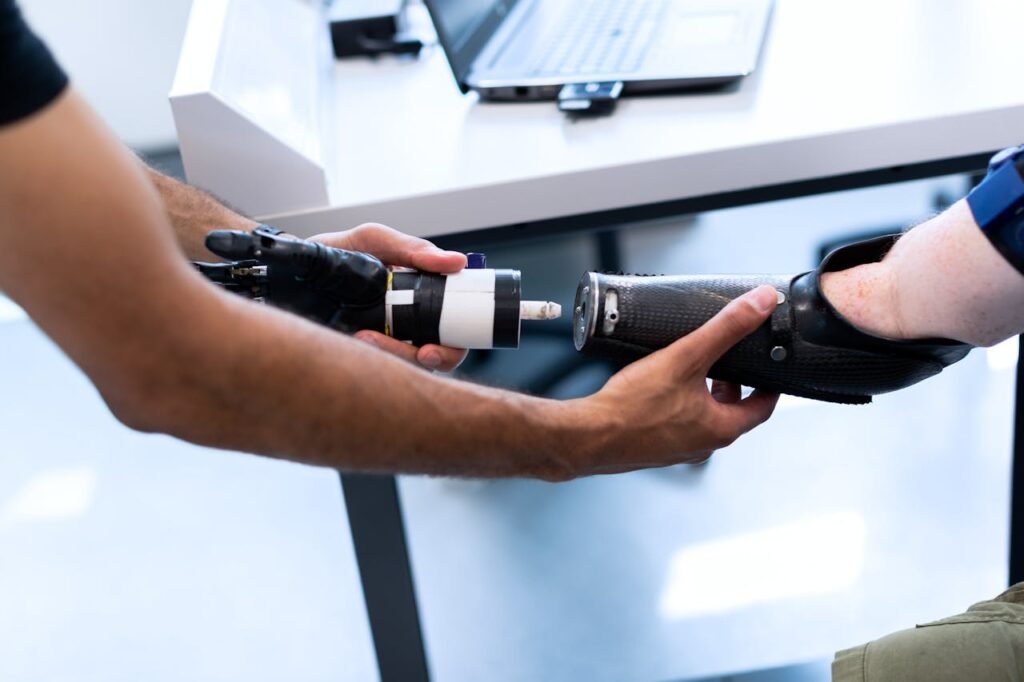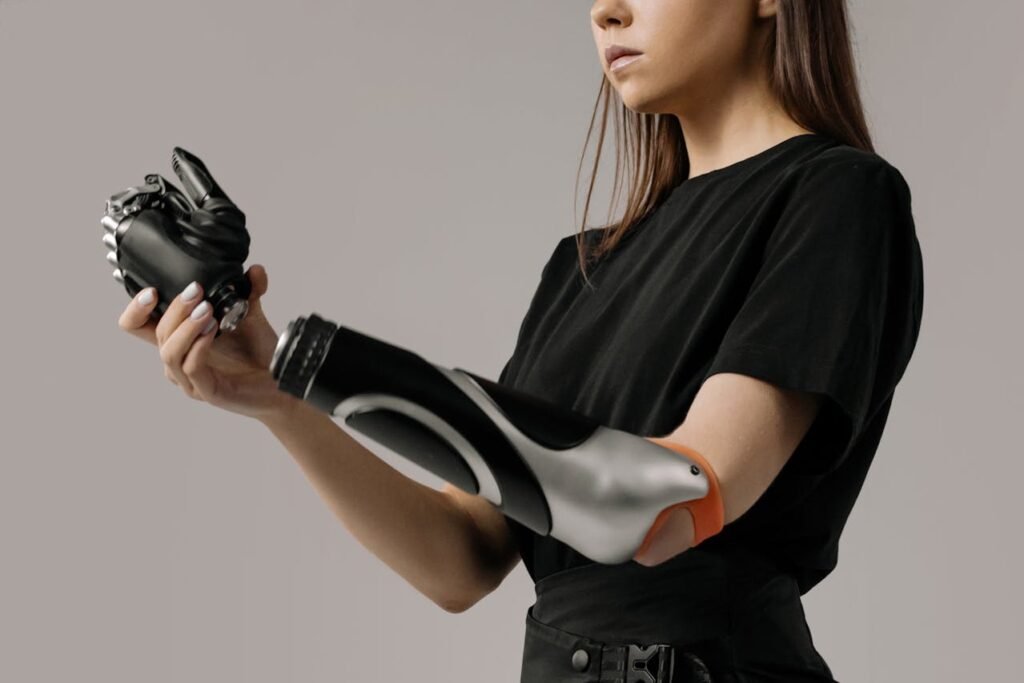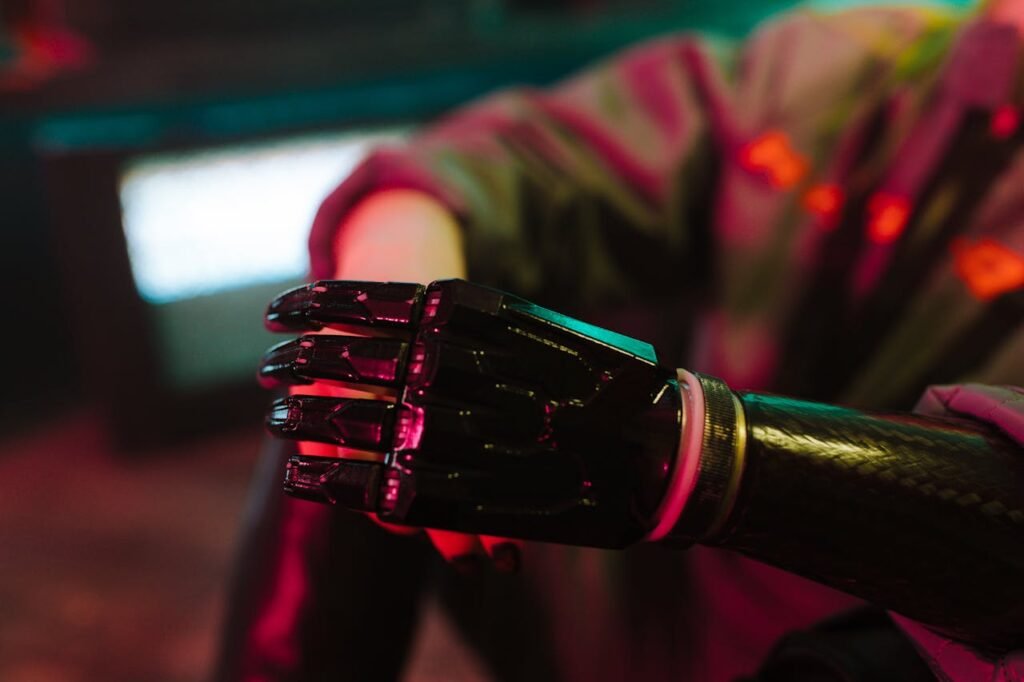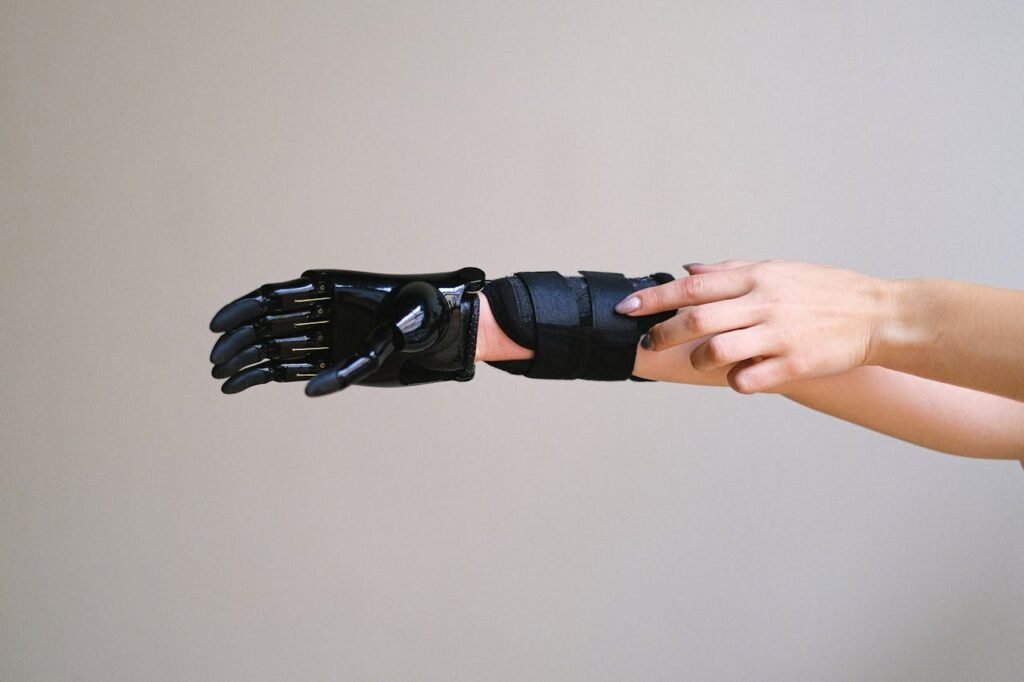For many upper limb amputees, the journey does not end with getting a prosthetic hand or arm. The real challenge begins with learning how to control it with ease and confidence. Even the most advanced prosthetics depend on one key factor — the user’s ability to generate clear and reliable muscle signals.
This is where problems often arise. After surgery, residual muscles may become weak, underused, or inconsistent in sending signals. Without strong and steady input, controlling a prosthetic can feel frustrating, tiring, and less natural.
Electrical Muscle Stimulation, or EMS, is being explored as a way to change this. By gently activating the muscles of the residual limb, EMS may not only keep them strong but also improve the clarity of signals sent to the prosthetic. The question is: can this really make prosthetic control better for upper limb amputees?
In this article, we will explore that question in depth. We will look at how prosthetics work, why muscle strength and nerve signals matter so much, and how EMS fits into the picture. We will also discuss practical applications for patients, families, and rehabilitation centers, along with the long-term potential of EMS in transforming upper limb prosthetic use.
How Prosthetic Control Works in Upper Limb Amputees
The Role of Residual Muscles

Modern prosthetics, especially myoelectric ones, rely on residual muscles in the arm or forearm to function. These muscles generate small electrical signals when the user thinks about moving the missing limb. Sensors in the prosthetic detect these signals and translate them into movement, such as opening or closing a hand. Without strong and responsive muscles, the signals can be too weak or inconsistent to control the prosthetic smoothly.
The Importance of Clear Myoelectric Signals
Every movement in a prosthetic hand depends on the clarity of myoelectric signals. If the signals are weak, the prosthetic may respond slowly or not at all. If they are unclear, the prosthetic may misinterpret commands, leading to clumsy or unintended actions. This makes daily activities — like holding a cup, typing, or buttoning a shirt — far more difficult.
Challenges After Amputation
After surgery, the body goes through major changes. Muscles that once controlled the hand or arm may shrink from lack of use, a process called atrophy. Nerve signals can also become less coordinated. Together, these challenges make it harder to produce the steady signals a prosthetic needs. Many amputees struggle with this stage, feeling frustrated that their new prosthetic does not feel natural.
The Role of Rehabilitation in Control
Rehabilitation is key to overcoming these challenges. Through exercises, therapy, and training, amputees can strengthen residual muscles and retrain their nerves. This not only helps with physical strength but also improves the quality of myoelectric signals. Stronger signals mean smoother, more natural prosthetic movements, which builds confidence and independence in daily life.
Why Muscle Strength and Control Matter for Prosthetic Use
Muscle Strength as the Foundation

A prosthetic hand is only as good as the muscles that control it. When residual muscles are strong, they send steady and powerful signals to the prosthetic sensors. This makes it easier to perform smooth movements like gripping, lifting, or rotating. Without this foundation, the prosthetic feels less like a part of the body and more like a heavy tool.
The Link Between Strength and Endurance
It is not enough for muscles to be strong for a short time. Prosthetic users need endurance to use their device for hours each day. Weak muscles tire quickly, which means the prosthetic becomes harder to control as the day goes on. This often leads to frustration and, in some cases, rejection of the prosthetic altogether.
Fine Motor Control for Daily Tasks
Many of life’s daily activities depend on precise movements. Buttoning a shirt, holding a pen, or picking up small objects require fine motor control. This control comes from consistent and clear muscle signals. If the muscles lack coordination, the prosthetic cannot move with the needed accuracy, making simple tasks stressful.
Challenges in Building Muscle Strength After Amputation
Atrophy in Residual Muscles
Once the limb is lost, the muscles that once connected to it are used less frequently. Without exercise or therapy, these muscles shrink and weaken. This atrophy makes it difficult to produce strong signals for the prosthetic, slowing down the rehabilitation process.
Nerve Confusion and Phantom Signals
Nerves do not always adapt smoothly after amputation. Some send false signals, leading to phantom sensations. Others fire irregularly, making it harder for prosthetic sensors to interpret them correctly. This nerve confusion adds another layer of difficulty for amputees learning to control their device.
Emotional and Physical Fatigue
Strengthening residual muscles takes time and effort. Many patients feel discouraged when they cannot see immediate results. Combined with the physical pain of recovery, this emotional fatigue sometimes causes people to lose motivation. Without consistent training, progress slows, and prosthetic control suffers.
Introducing EMS as a Supportive Tool
What EMS Does for Residual Muscles

Electrical Muscle Stimulation provides a way to activate muscles without requiring full voluntary effort. By sending mild pulses through electrodes placed on the skin, EMS contracts the muscles in a controlled way. This keeps the muscles engaged, even when the patient cannot exercise them fully.
Helping the Brain-Muscle Connection
Each contraction triggered by EMS sends feedback to the brain. This feedback helps strengthen the communication between nerves and muscles. Over time, this can improve the clarity of myoelectric signals, making it easier for the prosthetic sensors to detect and respond accurately.
Preparing for Prosthetic Training
Perhaps the most important role of EMS is in preparing amputees for prosthetic training. Instead of starting with weak, underused muscles, patients enter rehabilitation with stronger, more responsive muscle tissue. This shortens the adjustment period and makes the prosthetic feel more natural, more quickly.
Practical Applications of EMS in Prosthetic Training
EMS in Rehabilitation Clinics
In clinics, EMS is often introduced during the early stages of rehab, sometimes even before a prosthetic fitting. Therapists place electrodes on targeted residual muscles and adjust the stimulation to create controlled contractions. These sessions are guided, which means therapists can check whether the muscles are responding properly and adapt the settings as needed. Patients often combine EMS with guided exercises, ensuring that stimulation translates into functional strength.
Preparing for Myoelectric Prosthetics
For myoelectric prosthetic users, clear signals are everything. EMS helps condition the muscles so that when sensors are placed on the limb, they pick up reliable signals. Clinics often run EMS sessions alongside myoelectric training, giving patients a head start. Instead of struggling with weak signals, the user begins training with stronger, sharper muscle responses. This makes it easier to practice gripping, holding, and releasing objects during therapy.
Home-Based EMS Training
One of the biggest strengths of EMS is that it can also be used at home. Portable EMS devices allow patients to continue muscle conditioning outside the clinic. Therapists usually provide guidance on electrode placement, safe intensity levels, and session duration. Home training builds consistency, which is key for long-term improvement. Patients who use EMS at home often arrive at clinic sessions stronger, making faster progress with prosthetic training.
Structuring an EMS Routine
A typical EMS program begins with short sessions, about 15–20 minutes, a few times a week. As muscles get stronger, session length and intensity gradually increase. For patients preparing for prosthetic fitting, EMS routines are often paired with functional tasks, such as practicing opening and closing motions. This bridges the gap between passive muscle training and active prosthetic use, ensuring smoother adaptation when the device is fitted.
Addressing Phantom Limb Pain During Training
Many amputees also deal with phantom limb pain, which can disrupt prosthetic training. EMS can play a dual role here by not only strengthening muscles but also calming overactive nerve signals. Patients often report reduced phantom pain after sessions, allowing them to focus more fully on learning prosthetic control. This makes EMS an even more valuable tool in the rehabilitation process.
The Benefits of EMS for Businesses and Clinics
Improving Patient Outcomes

For rehabilitation centers and prosthetic providers, EMS offers a way to enhance patient outcomes. Stronger muscles and clearer signals mean faster adaptation to prosthetics, fewer training setbacks, and higher patient satisfaction. When patients see results quickly, they are more motivated to continue with therapy and more likely to recommend the clinic to others.
Offering Complete Care Packages
Clinics can differentiate themselves by offering EMS as part of structured rehabilitation packages. Instead of treating EMS as an optional add-on, integrating it into recovery programs creates a complete care pathway — from surgery to prosthetic mastery. Families and patients value this holistic approach, seeing it as modern, professional, and supportive.
Reducing Dropout Rates
One of the biggest challenges in prosthetic training is dropout, when patients stop using their devices due to frustration. By making prosthetic control easier and less tiring, EMS reduces these dropouts. For businesses, this means stronger long-term engagement with patients and better success rates to showcase in reports and marketing materials.
Long-Term Role of EMS in Sustaining Prosthetic Control
Building Endurance for Daily Use
Learning to control a prosthetic is one thing — using it all day is another. Many amputees find that their muscles fatigue quickly, making the prosthetic harder to operate after a few hours. EMS helps by training residual muscles not just for strength, but also for endurance. Regular stimulation builds stamina, so patients can rely on their prosthetic for longer periods without discomfort or fatigue.
Supporting Fine Motor Skills Over Time
Tasks like writing, eating, or using a smartphone demand precision. For prosthetic users, this requires not only initial training but also ongoing muscle conditioning. EMS reinforces this by keeping muscle signals sharp and coordinated. Even years after fitting a prosthetic, patients benefit from occasional EMS sessions that refresh their control and prevent loss of fine motor ability.
Reducing Muscle Imbalance
Upper limb amputees often overuse their intact limb to compensate. This creates imbalance, strain, and sometimes pain in the stronger side. By keeping residual muscles active, EMS helps distribute the workload more evenly. This reduces the risk of overuse injuries and supports healthier long-term posture and movement patterns.
Helping During Setbacks
Recovery is rarely a straight line. Illness, injury, or even device repair periods can interrupt prosthetic training. During these times, EMS acts as a safety net. Even if the prosthetic is not in use, residual muscles stay engaged through EMS. This ensures that when training resumes, the patient does not lose months of progress and can return to control much more smoothly.
Enhancing Emotional Confidence
Prosthetic training is not just about the body — it is deeply emotional. Many amputees feel discouraged when progress seems slow. EMS provides visible and tangible signs of improvement, which boosts confidence. Seeing muscles contract and signals grow stronger reassures patients that they are on the right path. This emotional lift can be the difference between giving up and pushing forward.
Adapting EMS Into Everyday Life
Making EMS Part of Routine

For long-term results, EMS works best when it becomes part of a patient’s lifestyle. Just like brushing teeth or exercising, short sessions can be built into daily or weekly schedules. Patients who commit to a routine often notice steady improvements in prosthetic control, even years after amputation.
Using EMS Alongside Prosthetic Practice
Many therapists encourage patients to pair EMS sessions with functional prosthetic training. For example, a session may begin with EMS stimulation to activate the muscles, followed by practice with gripping objects or performing daily tasks. This combination helps bridge the gap between artificial contractions and real-life control, making prosthetic use smoother.
Flexibility for Changing Needs
As life changes, so do rehabilitation goals. A student may need endurance for typing, while a worker may need grip strength for tools. EMS can adapt easily by adjusting frequency, intensity, and placement. This flexibility makes it a lifelong tool that grows with the patient’s changing needs.
The Science Behind EMS for Prosthetic Control
How EMS Strengthens the Brain-Muscle Connection
When EMS contracts residual muscles, it does more than strengthen them physically. It also improves communication between the brain and the muscles. Each contraction sends signals back to the nervous system, training the brain to recognize and respond to these pathways more clearly. Over time, this “rewiring” helps reduce noise in the system and produces signals that prosthetic sensors can detect more reliably.
Neuroplasticity and Prosthetic Learning
The brain is not fixed — it can adapt and reorganize itself, a process known as neuroplasticity. After amputation, the brain struggles with the loss of input from the missing limb. EMS provides consistent input through muscle contractions, which encourages the brain to build new connections. This supports prosthetic learning, making movements feel more natural as the brain begins to accept the prosthetic as part of the body.
Evidence From Clinical Studies
Research on EMS in amputee rehabilitation is still emerging, but early results are promising. Studies show that patients who use EMS often demonstrate stronger myoelectric signals, quicker adaptation to prosthetics, and greater satisfaction in daily use. While more large-scale trials are needed, the evidence so far suggests that EMS has a valuable role in bridging the gap between muscle conditioning and prosthetic control.
Business Opportunities for Clinics and Providers
Differentiating Through Innovation
Rehabilitation centers and prosthetic providers face competition in attracting and retaining patients. Offering EMS as part of rehabilitation sets a business apart. It positions the clinic as innovative, patient-centered, and ahead of the curve in adopting modern methods. This not only draws more patients but also builds stronger relationships with surgeons, insurers, and partner organizations.
Packaging EMS as a Service
Instead of offering EMS in isolation, clinics can design structured programs that include EMS sessions alongside physiotherapy and prosthetic training. Bundled services create a sense of comprehensive care, giving families confidence that they are receiving the best possible support. These packages also allow clinics to generate steady revenue streams while delivering measurable value.
Building Long-Term Engagement
Patients often disengage once their prosthetic is fitted, even though ongoing care is crucial. By offering EMS as a long-term maintenance service, clinics can keep patients connected. Regular check-ins and EMS programs not only improve patient outcomes but also strengthen loyalty. This long-term engagement supports both the patient’s health and the clinic’s sustainability.
Demonstrating Measurable Outcomes
One of the biggest advantages for businesses is that EMS progress can be measured. Muscle strength, signal clarity, and endurance improvements can all be tracked and shared with patients. This data-driven approach helps build trust, provides material for case studies, and strengthens the clinic’s reputation as an evidence-based provider.
The Future of EMS in Prosthetic Control
Smarter Devices With Integrated Feedback

Future EMS devices may integrate sensors that give instant feedback to patients and therapists. These systems could track progress, adjust intensity automatically, and even connect with prosthetic sensors in real time. Such integration would make the training process smoother, more precise, and more personalized.
Combining EMS With Virtual Training
Virtual reality and gamified rehabilitation are gaining traction in prosthetic training. Combining EMS with these tools could create highly engaging programs. For example, patients could practice moving a virtual hand while EMS activates their residual muscles. This blend of stimulation and visualization would accelerate learning and make therapy more motivating.
Accessibility and Affordability
As technology advances, EMS devices are becoming more affordable and portable. This opens doors for home-based rehabilitation programs, especially in regions where access to specialized clinics is limited. Businesses that adopt these accessible models early will play a key role in making advanced rehabilitation available to more amputees worldwide.
A Future of Integration
The real future of EMS lies not in replacing existing methods but in integrating with them. By combining EMS with physiotherapy, occupational therapy, mirror therapy, and prosthetic training, patients receive a holistic pathway to recovery. Clinics that embrace this integrated future will lead the way in setting new standards for amputee care.
Can EMS Improve Prosthetic Control in Upper Limb Amputees?
The Short Answer
Yes, EMS can make a real difference in improving prosthetic control for upper limb amputees. By strengthening residual muscles, improving endurance, calming nerve confusion, and training the brain-muscle connection, EMS helps patients generate clearer signals. These signals are the very foundation of smooth prosthetic function.
What Patients Should Know
For patients, EMS is not a miracle cure — but it is a powerful tool when used consistently. It works best as part of a structured rehabilitation plan, not as a stand-alone solution. Pairing EMS with physiotherapy, occupational training, and regular prosthetic practice brings the strongest results. Patients should also be prepared for gradual progress, as improvements build over weeks and months, not days.
What Clinics Should Do
For clinics and prosthetic providers, EMS is both a medical tool and a business opportunity. Offering EMS shows innovation, creates more complete care packages, and reduces dropout rates. Training staff to use EMS correctly, educating families about its benefits, and tracking measurable results will set businesses apart as leaders in amputee rehabilitation.
Balancing Expectation and Reality
It is important to manage expectations carefully. Not every patient will respond the same way to EMS. Some may experience dramatic improvements in prosthetic control, while others may notice only moderate gains. The key is consistency, personalization, and integrating EMS into a broader program rather than relying on it alone.
Conclusion
Upper limb prosthetics have come a long way, but their success depends on the user’s ability to generate strong, clear, and steady signals. This is where many amputees face challenges, especially in the early months after surgery. EMS provides a way to bridge the gap — keeping muscles strong, signals sharp, and the brain engaged.
For patients, EMS means more control, more confidence, and more independence. For clinics, it means better outcomes, stronger engagement, and a reputation for innovation. For families, it means hope that recovery is not only possible but also sustainable.
So, can EMS improve prosthetic control in upper limb amputees? The answer is a resounding yes — not as a magic fix, but as a trusted partner in the journey. When paired with therapy, training, and perseverance, EMS empowers patients to make their prosthetics feel less like tools and more like extensions of themselves.
The future of prosthetic control is not just about advanced devices. It is about giving the body and brain the best chance to adapt. EMS does exactly that, one pulse at a time.



